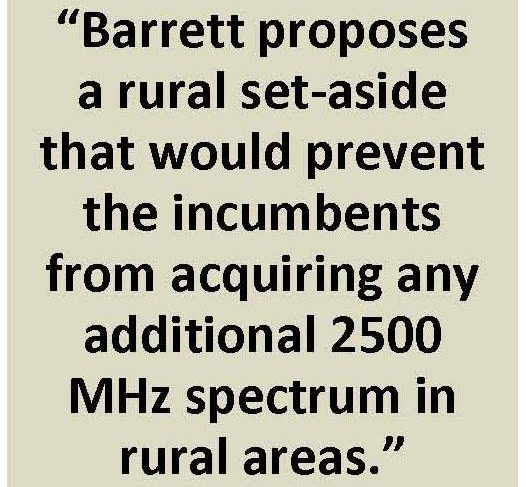
OTTAWA – Many wireless providers are telling Industry Canada that it should restrict Inukshuk Internet’s ability to fully participate in the 2500 MHz spectrum auction.
MTS Allstream, Quebecor Media Inc., Shaw Communications, Telus Corp., and EastLink all suggested in comments to the 2500 MHz licensing process that it would be unfair to allow Inukshuk unfettered bidding in the auction because it owns 98% of licensed 2500 MHz bandwidth and a considerable chunk of the overall band. Inukshuk is a joint venture between Bell Canada and Rogers Communications.
For MTS, it’s no longer a question of whether competition is needed in the band, but what the department should do to ensure a fair distribution of the remaining 2500 MHz bandwidth. “The question is: Which measures should be adopted to ensure an equitable distribution of what little 2500 MHz spectrum remains in light of (i) the excessive spectrum holdings of Bell and Rogers in the band and (ii) their vast relative access to capital?” asks MTS in its reply comments.
The regional wireless provider, along with Quebecor and Shaw, argued against a set aside, recommending instead an auction cap as a way to ensure fair auction process.
“We believe that a properly structured in-band auction cap can achieve the required balance between enabling a sufficient block size and encouraging multiple winners in the auction, all in a manner that causes the least possible distortion to market forces,” states Quebecor.
Even Rogers, in its initial comments, preferred an auction cap to a set aside. “Unlike a set-aside, an auction cap creates few if any gaming opportunities. An auction cap only limits how much spectrum a bidder can obtain, not which specific license blocks are available to it. Every bidder therefore can place bids upon any licence as long as they do not exceed the cap. The cap ensures there are multiple winners in the auction without the distortions and waste created by a set-aside.”

Telus altered its position with respect to an auction cap. The company still supports such a cap, but believes if set at 40 MHz (both paired and unpaired spectrum combined) it would work best and prevent the incumbent from acquiring spectrum that was returned prior to this process.
The company believes that “a band cap represents the fairest tool to allocate the clawback and residual 2500 MHz spectrum given the vast new mobile holdings the fixed service licence holders automatically gained upon the transition to mobile.”
EastLink contends that a set aside is the right policy choice. It suggests that a set aside provision should be constructed in a way that ensures at least two providers who have less than 10% national market share are able to acquire spectrum. But the company goes further: “To ensure consumers have competitive service options in those regions, all of Inukshuk, Bell and Rogers (referred to herein as “Inukshuk”), should be banned from participation in the 2500 MHz spectrum auction,” the company writes in its reply comments.
For Barrett Xplore Inc., one of the key goals of licensing bandwidth in the 2500 MHz band, should be to enable rural broadband providers to rollout services in under-served areas. Rather than allowing the mobile incumbents to acquire additional spectrum, which Barrett claims “will do very little” to make affordable broadband available to rural Canadians, Industry Canada should implement mechanisms that allow rural ISPs “to gain affordable – and economically fair (i.e., market price)– access to rural spectrum.”
The company suggests that there two ways to effectively accomplish this: remove rural portions of some tier 4 licences and set aside spectrum for rural broadband providers. Barrett describes its approach as rural unbundling and that it would affect a fraction of the total number of licences – 47 licences or 27% of the total available.
“Indeed, the rural unbundling would leave the total number of Tier 4 service areas unchanged at 172,” it says.
Unbundling the rural component of some licences will go only part of the way, says Barrett, adding more “pro-competitive measures” such as spectrum caps or set asides need to be considered. “In particular, Barrett proposes a rural set-aside that would prevent the incumbents from acquiring any additional 2500 MHz spectrum in rural areas,” the company says. It also agrees that an in-auction cap would work.
It should come as no surprise that both Bell and Rogers are opposed to any restrictions in the auction. Bell says that an “unrestrained” spectrum auction is the best approach.

“Canada should continue to rely on real world investors and consumers, as opposed to bureaucratic judgment, for determining who values the spectrum the most and hence who will put the spectrum to its most efficient and best use,” Bell says.
Rogers tells Industry Canada that it shouldn’t be penalized through auction restrictions when it took the risk with this spectrum. The company also blasted parties calling for the restrictions because rather than trying acquire 2500 MHz spectrum – either through acquiring Microcell years ago or buying other spectrum licenses such as from Craig Wireless, YourLink and Look Communications more recently – they want the government to give them a leg up on the incumbents.
“They are asking the government to bail them out with discriminatory auction rules and to punish Inukshuk for taking the risk and making the necessary investments in the band,” states Rogers.
No word yet on when Industry Canada will release its decision on the 2500 MHz auction.



